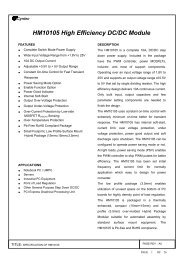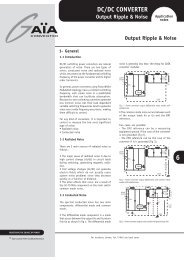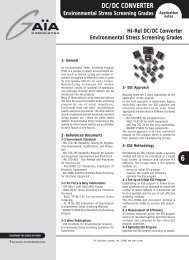HM03145 High Efficiency DC/DC Module
HM03145 High Efficiency DC/DC Module
HM03145 High Efficiency DC/DC Module
Create successful ePaper yourself
Turn your PDF publications into a flip-book with our unique Google optimized e-Paper software.
APPLICATION INFORMATION<br />
Power GOOD Output<br />
The power good output is an open-drain<br />
output and requires a pull-up resistor. When<br />
the output voltage is 20% above 10% below<br />
its set voltage, PGOOD gets pulled low. It is<br />
held low until the output voltage returns to<br />
within these tolerances once more. PGOOD is<br />
also held low during start-up and will not be<br />
allowed to transient high until soft start is over<br />
(440 switching cycles) and the output reaches<br />
90% of its set voltage. There is a 5uS delay<br />
built into the PGOOD circuitry to prevent false<br />
transitions.<br />
Output Over-Voltage Protection<br />
When the output exceeds 20% of its set<br />
voltage then the low-side MOSFET is latched<br />
on. That is discharging output energy to low<br />
side MOSFET which is in order to avoiding<br />
high voltage to damage the load. It stays<br />
latched on and the module is latched off until<br />
reset. There is a 5uS delay built into the over<br />
voltage protection circuit to prevent false<br />
transitions.<br />
Output Under-Voltage Protection<br />
When the output voltage is 10% below its set<br />
voltage the output is latched in tri-stated<br />
condition. It stays latched and the module is<br />
latched off until reset. There is a 5uS delay<br />
built into the under voltage protection circuit to<br />
prevent dales transitions.<br />
Note: to reset from any fault, PVCC or<br />
EN/PSV must be toggled.<br />
Over-Temperature<br />
When an OTP fault is detected, the <strong>HM03145</strong><br />
over temperature protection circuit suspends<br />
PWM, but will not affect the PGOOD pin, or latch<br />
off the <strong>HM03145</strong>. The over temperature<br />
protection circuit measures the temperature of the<br />
silicon and activates when the rising threshold<br />
temperature TP OTPL has been exceeded.<br />
Power-On Reset, UV Lockout and Soft Start<br />
An internal power-on reset (POR) occurs when<br />
PVCC exceeds 3V, starting up the internal<br />
biasing. PVCC under voltage lockout (UVLO)<br />
circuitry inhibits the module until PVCC rises<br />
above 4.2V. At this time the UVLO circuitry resets<br />
the fault latch and soft-start counter, and allows<br />
switching to occur if the device is enabled.<br />
Switching always starts with low-side switch<br />
signal to charge up the bootstrap capacitor. With<br />
the soft-start circuit (automatically) it will<br />
progressively limit the output current (by limiting<br />
the current out of the ISEN pin) over a<br />
predetermined time period of 440 switching<br />
cycles.<br />
The ramp occurs in four steps:<br />
(1) 110 cycles at 25% ISEN with double minimum<br />
off-time (for purposes of the on-time one-shot,<br />
there is an internal positive offset of 120mV to<br />
VOUT during this period to aid in startup).<br />
(2) 110 cycles at 50% ISEN with normal minimum<br />
off time.<br />
(3) 110 cycles at 75% ISEN with normal minimum<br />
off-time.<br />
(4) 110 cycles at 100% ISEN with normal<br />
minimum off time.<br />
TITLE: SPECIFICATION OF <strong>HM03145</strong><br />
PAGE REV:A1<br />
PAGE 14 OF 30
















